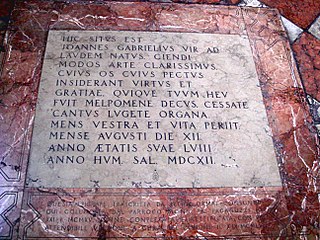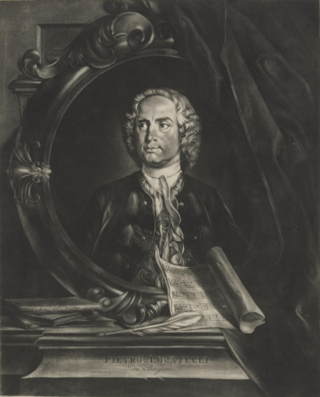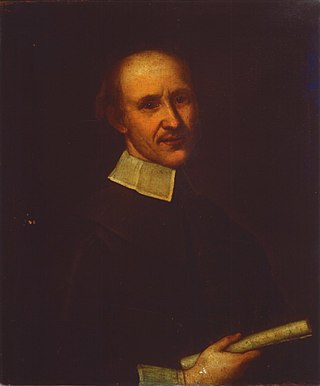Works

- Sonate Concertate in Stil Moderno, Libro I, Venice, 1621
- Sonate Concertate in Stil Moderno, Libro II, Venice, 1629
- Exultate Deo, motet (Ghirlanda sacra 1625 and 1636).
Dario Castello (Venice, bapt. 19 October 1602 - Venice 2 July 1631) [1] was an Italian composer and violinist from the early Baroque period who worked and published in Venice. As a composer, he was a late member of the Venetian School and had a role in the transformation of the instrumental canzona into the sonata.
Dario Domenico Castello was born in Venice, where he was baptised on 19 October 1602. [2]
The title page of the 1621 edition of the first volume of the Sonate Concertate in stil moderno records him as Capo di Compagnia de Musichi d'Instrumenti da fiato in Venetia, indicating that he led a Venetian company of piffari , a band that could include sackbuts, cornetts, shawms, but also violins and viols.
On 19 November 1624 he was appointed «sonador di violin» (violin player) of the St. Mark's music chapel, at the time headed by Claudio Monteverdi. [3]
The title page of the second volume (1629) of the "Sonate concertate in Stil moderno" lists him as Musico Della Serenissima Signoria di Venetia in S. Marco, & Capo di Compagnia de Instrumenti, indicating that he worked at the great Basilica of St. Mark's where Claudio Monteverdi was maestro di capella. Castello's use of the stile concitato (agitated style) —with quick repeated-note figures— is consistent with his association with Monteverdi.
His brother Francesco (trombonist) and his father Giovanni Battista (violinist) also were working at St Mark's.
Dario Castello died in Venice on 2 July 1631 during the great plague of 1630. [4]
Of his music, 29 separate compositions survive. Castello's music is inventive and technically challenging. Strictly worked polyphonic sections alternate with dramatic recitatives over basso continuo, in keeping with the title of the publications "in stil moderno"; however he also uses some of the older canzona technique, which uses short sections of highly contrasting texture, and active rather than lyrical melodic lines. Unusually for the time, Castello often specifies the instruments for each part, calling for cornetti, violins, sackbuts and dulcians. That these works were still being reprinted in the 1650s attests to Castello's influence. Modern editions of the complete sonatas are published by Ut Orpheus Edizione.


The term sackbut refers to the early forms of the trombone commonly used during the Renaissance and Baroque eras. A sackbut has the characteristic telescopic slide of a trombone, used to vary the length of the tube to change pitch, but is distinct from later trombones by its smaller, more cylindrically-proportioned bore, and its less-flared bell. Unlike the earlier slide trumpet from which it evolved, the sackbut possesses a U-shaped slide with two parallel sliding tubes, rather than just one.

Tomaso Giovanni Albinoni was an Italian composer of the Baroque era. His output includes operas, concertos, sonatas for one to six instruments, sinfonias, and solo cantatas. While famous in his day as an opera composer, he is known today for his instrumental music, especially his concertos. He is best remembered today for a work called "Adagio in G minor", attributed to him but largely written by Remo Giazotto, a 20th century musicologist and composer, who was a cataloger of the works of Albinoni.

Giovanni Gabrieli was an Italian composer and organist. He was one of the most influential musicians of his time, and represents the culmination of the style of the Venetian School, at the time of the shift from Renaissance to Baroque idioms.

Pietro Antonio Locatelli was an Italian Baroque composer and violinist.

The Venetian polychoral style was a type of music of the late Renaissance and early Baroque eras which involved spatially separate choirs singing in alternation. It represented a major stylistic shift from the prevailing polyphonic writing of the middle Renaissance, and was one of the major stylistic developments which led directly to the formation of what is now known as the Baroque style. A commonly encountered term for the separated choirs is chori spezzati—literally, "broken choruses" as they were called, added the element of spatial contrast to Venetian music. These included the echo device, so important in the entire baroque tradition; the alternation of two contrasting bodies of sound, such as chorus against chorus, single line versus a full choir, solo voice opposing full choir, instruments pitted against voices and contrasting instrumental groups; the alternation of high and low voices; soft level of sound alternated with a loud one; the fragmentary versus the continuous; and blocked chords contrasting with flowing counterpoint.

Tarquinio Merula was an Italian composer, organist, and violinist of the early Baroque era. Although mainly active in Cremona, stylistically he was a member of the Venetian school. He was one of the most progressive Italian composers of the early 17th century, especially in applying newly developed techniques to sacred music.

Giovanni Legrenzi was an Italian composer of opera, vocal and instrumental music, and organist, of the Baroque era. He was one of the most prominent composers in Venice in the late 17th century, and extremely influential in the development of late Baroque idioms across northern Italy.
Marcantonio Negri was an Italian composer, singer, and musical director of the early Baroque era. He was in the musical establishment of St. Mark's Basilica in Venice at the same time as Monteverdi, and was well known as a composer at the time.
Giovanni Picchi was an Italian composer, organist, lutenist, and harpsichordist of the early Baroque era. He was a late follower of the Venetian School, and was influential in the development and differentiation of instrumental forms which were just beginning to appear, such as the sonata and the ensemble canzona; in addition he was the only Venetian of his time to write dance music for harpsichord.
Giovanni Valentini was an Italian Baroque composer, poet and keyboard virtuoso. Overshadowed by his contemporaries, Claudio Monteverdi and Heinrich Schütz, Valentini is practically forgotten today, although he occupied one of the most prestigious musical posts of his time. He is best remembered for his innovative usage of asymmetric meters and the fact that he was Johann Kaspar Kerll's first teacher.
Marco Uccellini was an Italian Baroque violinist and composer. His output of mainly secular music for solo violin is considered to have been important in the rise of independent instrumental classical music, and in the development of violin technique.
Biagio Marini was an Italian virtuoso violinist and composer in the first half of the seventeenth century.

Cetra, a Latin word borrowed from Greek, is an Italian descendant of κιθάρα (cithara). It is a synonym for the cittern but has been used for the citole and cithara and cythara.
The year 1614 in music involved some significant musical events.
In the years centering on 1600 in Europe, several distinct shifts emerged in ways of thinking about the purposes, writing and performance of music. Partly these changes were revolutionary, deliberately instigated by a group of intellectuals in Florence known as the Florentine Camerata, and partly they were evolutionary, in that precursors of the new Baroque style can be found far back in the Renaissance, and the changes merely built on extant forms and practices. The transitions emanated from the cultural centers of Northern Italy, then spread to Rome, France, Germany, and Spain, and lastly reached England . In terms of instrumental music, shifts in four discrete areas can be observed: idiomatic writing, texture, instrument use, and orchestration.
Giovanni Battista Vitali was an Italian composer and violone player.
His Majestys Sagbutts & Cornetts (HMSC) is a British early music group founded in 1982. The ensemble presently consists of three cornetts and four sackbuts, with chamber organ or harpsichord. The group frequently collaborates with other instrumentalists and singers, and has an extensive discography on Hyperion Records and other labels.
Musica Fiorita was an ensemble for baroque music founded in 1990 and based in Basel, which was conducted by the harpsichordist Daniela Dolci. The ensemble concentrated in particular on rediscovering unknown works by composers of the 17th and 18th centuries and their historical performance practice. In March 2020, it ceased its concert activities.
Giuseppe Scarani was an Italian organist, singer and composer.